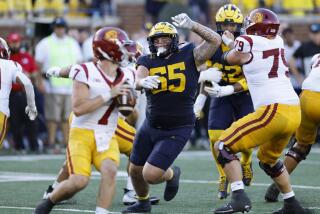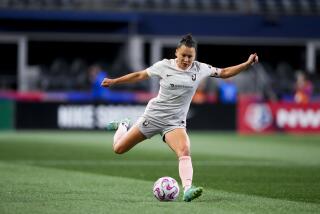PAIN AS PART OF THE GAME : Players Must Take Agony With Ecstasy
- Share via
Sports are a last-second finger-tip catch in the end zone. A home run in the bottom of the ninth. A wedge of sprinters gasping and leaning toward the finish line. A downhill run on fresh-packed snow.
Sports are exhilaration, heartbreak, the maximized effort by the talented.
But sports are also a pain in the butt. And elbow. And knee. Not to mention wrist, ankle and hip.
Play any game long enough, no matter the conditions or your conditioning, and one thing is certain: You are bound to get hurt. The more physically demanding the sport, the greater the chance.
High school athletes are not immune. Look on the sidelines during any Friday night football game, and you’re bound to see one or two players in casts or heavy bandages. Volleyball players wear a rainbow collage of bruises from diving on floors. Let a gymnast land awkwardly after a double somersault from the uneven bars, and . . . ouch.
Even a badminton shuttlecock, which can travel up to 110 m.p.h., can hurt if it hits in the right spot.
Despite tremendous strides in conditioning, technology, equipment, facilities and coaching, kids still go bump in the night.
“I like to think sports are less dangerous, but I don’t know if anyone has proved that,” said Dr. Craig Milhouse, medical director at Anaheim Memorial Sports Medicine. “There will be injuries, but I think in a lot of areas many are from overuse--where people practice too much and won’t stop when they feel pain. They don’t listen to their bodies.
“If it seems like we’re seeing more injuries, it’s only because we’re looking for more and are more knowledgeable. The way we approach things with more trainers and more sports-trained physicians, we can identify an injury that a kid doesn’t get back on the field with.”
That, along with conventional and unconventional rehabilitation methods, has saved the seasons of two key Orange Country athletes.
Los Alamitos junior Kevin Feterik had earned the starting quarterback job, but broke his left (throwing) hand in the first half of the season opener against Kennedy. Feterik had been hurt before--breaking a finger and an elbow as a child--but never playing football, which he has played since he was 8.
“I was devastated; this was my first varsity game and first chance to prove myself,” said Feterik, 17. “We were winning, and I wanted to finish. I thought I’d be out five to six weeks and my season was done. I was real down, although winning the game helped.”
Disregarding an initial prognosis that would have sidelined him until league play began, Feterik sought the care of San Clemente therapist Benny Poda, who prescribed acupuncture, vitamin C, amino acids and herbs. Feterik did not get a hard plaster cast, opting instead for a soft plastic covering. He was back playing by Oct. 7 against Long Beach Millikan.
Feterik said the injury gave him a new sense of his vulnerability.
“All the time you hear about people getting hurt, but I never realized how lucky I was until that game. Now I’m not taking being healthy for granted. At any time you can be hurt. You still go 100%, but it made me realize you’re not invincible.”
Likewise, cross-country runner Jessica Corbin was expected to lead the Irvine girls’ team to glory similar to last year’s State Division I championship. But in late August, while attending a training camp, the junior began feeling pain in her left leg and hip.
“I don’t know how it happened,” said Corbin, 16. “My training was going so good--I was running, lifting weights, dieting. Everything was perfect. I had run 11 miles once, and averaged four to five miles a practice.”
When Corbin was first examined, the diagnosis was a pinched nerve in her back triggering the pain. Later, it was discovered she had Pirifomis syndrome, in which the muscle pressures the sciatic nerve.
But before that, Corbin was nearly done in by her treatment. A large daily dose of ibuprofen was first prescribed, but it began tearing up Corbin’s stomach, causing internal bleeding. Corbin continued to run, wondering why her performance was slipping; soon she had more serious problems: anemia, a throat-and-sinus virus and viral bronchitis.
Like Feterik, Corbin was worried her season was lost.
“What devastated me was coming down with the bronchitis,” she said. “I could run with the hip irritation, the internal stuff, but I couldn’t run with that. I came home from the trip to Stanford (Oct. 1), where we didn’t do too well, and I was in tears. There were so many emotions; I wanted to run but I knew I couldn’t. I knew my health comes before running, and it was now a health issue.”
After being told not to run for a week and changing medication, Corbin--who finished fifth Saturday at the Orange County Championships at Irvine Regional Park--said she’s recovered, at least mentally.
“My confidence went down a lot when I got injured, but I had to look at it as it was only six days that I was out. And six days in perspective is not really a lot. I had to do some soul searching, regain my confidence in myself. That’s the main thing; it wasn’t the injury, it was the loss of confidence and hope. I thought, ‘There goes college and everything.’ ”
Corbin’s injury was rare. Feterik’s was not.
“I don’t think kids are getting hurt any more now than 10 to 20 years ago,” said Joe Donohue, the physical therapist for the Corona del Mar and Fountain Valley high school football teams. “In my eight years as a therapist, I’ve seen the same type of injuries. Occasionally, you have one year of super athletes and the (number of) impacts are higher. But kids grow up the same; they may be 10 pounds heavier than they were 10 years ago, but that kind of thing evens out.”
According to area doctors and physical therapists, these are the types of injuries that most often occur in sports:
* Cross-country and track participants often sustain overuse injuries such as strained hamstrings, shin splints and tears in the plantar fascia (a fibrous band of tissue that connects heel to toe). Runners can get tendinitis in their knees.
* Football players sustain sprains, strains and broken bones, particularly in the legs. They are also vulnerable to stretched or torn ligaments.
* Basketball players suffer knee and ankle problems from jumping and twisting. They also tear up knees; there has been a rash of torn anterior cruciate ligament problems for both males and females in the high school and college games.
* Volleyball players have ankle problems, as well as shoulder problems from spiking.
* Swimmers, divers and water polo athletes have shoulder problems. There are occasional knee problems from the circular kick used in the breaststroke.
* Baseball and softball players have shoulder and arm problems, primarily from overuse.
* Golfers can suffer back problems from the twisting of the trunk during their swings. Not as prevalent are wrist and elbow problems.
* Wrestlers sustain injuries similar to football players.
* Tennis and badminton players develop difficulties in elbows and shoulders.
* Soccer players have all sorts of leg problems, including ankles and knees.
“Every sport has its unique injuries,” said Sean Higgs, a trainer at Fountain Valley High. “You’ll find studies that support the use of every brace, and you’ll find studies that say they don’t do any good. One of our keystones is taping. It’s mandatory for all football starters to be taped. But to say if it helps, how do you do a study on that? It seems to be working, but we have nothing to compare it to.”
No matter, the margins of safety have been increased.
Ron La Ruffa, Fountain Valley baseball coach, remembers coaching in the 1960s as “taking your 10 swings and 20 ground balls.”
“Now there are coaches for every phase of the game, even at high school,” he said. “Strength and conditioning dramatically improved. A kid has a much better education from the coaching.”
But the greatest progress is probably in football.
Dr. Fred Mueller, professor of physical education at the University of North Carolina, has studied catastrophic injuries--those causing death and permanent paralysis--among football players for more than 20 years. Because of refined equipment and rule changes, those kind of tragic incidents have dropped dramatically.
In 1968, there were 36 deaths in football, according to Mueller’s research. Twenty-six of the victims were high school players. Add to that an average of 25-30 accidents a year that resulted in paralysis in the late ‘60s. Among the reasons: “Teaching kids to block and tackle leading with their head into the chest,” Mueller said. “That could cause major damage to spinal cords.”
Starting in 1976, a nationwide rule change eliminated initial contact with head or face while blocking and tackling. Four years later, standards for the manufacturing of helmets for high school players were established. Add improved medical techniques, and the difference borders on astonishing.
In 1993, there were only four direct deaths, of them three were high school players. (In 1990, there was none, the first time since 1931.) There were only eight paralyzing injuries to high school players.
“To bring in the numbers that low is pretty good,” Mueller said.
Especially when you consider how sports continue to grow in popularity.
But soccer and cross-country, two of the state’s fastest growing participation sports among girls, have come under fire for the number of injuries they supposedly cause.
In 1993, the Consumer Product Safety Commission reported 76,766 general soccer injuries nationwide, of which 56,418 came during organized activities. Nearly 42% of these injuries occurred to players ages 15-24, with the most common being cuts, bruises, sprains and strains. The commission stated injuries tend to increase as players get older, from age 14 on, and girls generally sustained more injuries of all types than boys.
Meanwhile girls’ cross-country is receiving national scrutiny.
Dr. Stephen Rice, a faculty member of the University of Washington’s Division of Sports Medicine, conducted a 13-year study of about 60,000 high school athletes in 20 sports in the Seattle area. Among the findings:
* Fall sports had higher rates of injury than spring sports.
* The highest-risk sports include football, wrestling, gymnastics, cross-country (girls and boys) and soccer (girls and boys).
* Girls’ sports have higher rates of injury than counterpart boys’ sports.
* And finally, girls’ cross-country had the highest injury risk, according to the study. Out of 1,299 athletes tracked, 61.45% reported some type of injury. Football was next at 58.8%. In addition, girls’ cross-country had a 17.3% injury rate per 1,000 practices and meets. Football again was second, at 12.7%.
Cross-country “came out of the blue,” Rice said. “We did not come (to this study) with the idea we’d find this. If it had been football first and wrestling second, no one would have been interested.”
Rice believed the number of cross-country injuries--most of them being shin splints and muscle strains--came because girls had not always properly prepared during the summer before the season, then tried to do too much work in the fall. He also frowns at programs that have athletes running 50-70 miles a week in training. That, he contends, can lead to serious problems in still-developing skeletal structures.
Girls have another enemy--body fat, or specifically too little of it. Those with low estrogen levels who continue rigorous training can have menstrual cycles interrupted. That can also lead to the body’s inability to retain ingested calcium in the bones, which might lead to shin splints and stress fractures.
The report, naturally, was not warmly received by cross-country coaches, who feared hysterical reactions from parents concerned about the well-being of their children.
“The study . . . can be misleading,” said Randy Rossi, who coaches girls’ cross-country at Irvine. “But there are some legitimate concerns he addresses. More often than not, kids try to do too much too soon. But at Irvine, we’ve had no great injury problem, though we have had our share of shin splints and variety of aches and pains.
“As far as making sports safer, I think we’re heading in that direction. There’s more attention to preparation, and sports medicine keeps making leaps forward. I wasn’t pleased with (Rice’s) report, but it’s important we address the issues.”
Diane Hale has coached girls’ cross-country for 35 years, the last 20 at El Toro High. She, argues the sheer increase in participation has plenty to do with the rise in injuries.
“When we started at El Toro in 1975, I had five girls on the team,” Hale said. “Now I have 60. I’ll have injuries because I attract kids who want to be in a sport but do not have the background of being in athletics over long time. Some of the girls are starting fresh at 14 years old. Therein lies a problem.
“If I, as a runner, don’t have a good summer program to build a base on, I won’t be ready for the September workouts and break down. It’s not the conditioned runner that has problems that knock her out for six weeks.”
Rice knew some coaches would be angry once his study was published. “My response is I’m as surprised as anybody by the results,” he said. “But obviously there is something going on that is creating the problem.”
Even though athletes today are better coached, better protected, better conditioned and, when necessary, more easily healed, it’s still nearly impossible for them to avoid injury. Because if nothing else, kids will be kids.
More to Read
Go beyond the scoreboard
Get the latest on L.A.'s teams in the daily Sports Report newsletter.
You may occasionally receive promotional content from the Los Angeles Times.










